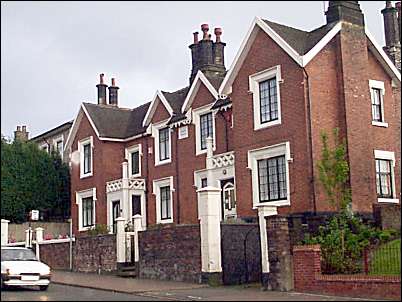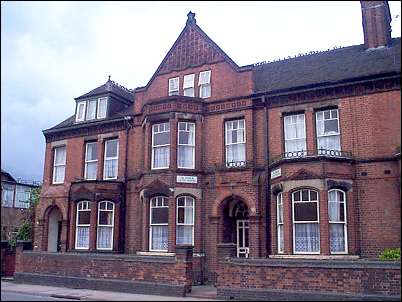|
Cobridge:
Cobridge is situated on and
around Waterloo Road - the main thoroughfare from Burslem to Hanley.
Waterloo Road climbs out of Burslem to the ridge at Cobridge Traffic lights
and from there drops down to Hanley whilst Cobridge Road drops down from the
traffic lights to Etruria and the Festival Park.
Waterloo Road was
built in two stages.
1) Hanley to
Cobridge: A “Plan of an Intended Road from Cobridge to Hanley”
dated 30 December 1811 shows that first part of the scheme was the
improvement of the connection between Cobridge and Hanley.
This section was in use by 1814.
2) Burslem to
Cobridge: The northern section from Burslem to Cobridge was
built between 1815 and 1817. As a result the old narrow winding
turnpike road was replaced a straight wide road. The new road
immediately became a focus of a new housing development.
"as we go further from
Burslem [into Cobridge] the houses become more recent and much
larger. This is the first middle-class area in Burslem and contains
a very good example of a mid-nineteenth century terrace in Camoys
Terrace. Baron Camoys was a descendant of the Biddulphs of the
Grange, and his commemorative terrace is brick mock-Tudor. "
'Portrait of the Potteries' - Bill Morland

Numbers 184-186 Waterloo Road
Camoys Terrace

Arnold Bennett's home No 205 Waterloo Road
Enoch Bennett, the father of Arnold Bennett, had bought a building
site on Henry Meakin’s estate for £200 in 1879 where he built a
house at a cost of £900, No 205 Waterloo Road. This is a large
three-storey red brick house with a façade much embellished with
terra cotta. It has two bay windows at the front and six bedrooms.
Bennett's Bleakridge
George B Ford (the architect of much of Cobridge)
may have been the model for Osmond Orgreave, the architect, who
featured in Arnold Bennett’s book, Clayhanger.
In his book Bennett provided a detailed and on the whole an accurate
description of the process of estate development in “Bleakridge”
(Cobridge):
“A house stood on a hill. And that
hill was Bleakridge, the summit of the little billow of land
between Bursley and Hanbridge.
Trafalgar Road passed over the crest of the billow. Bleakridge
was certainly not more than a hundred feet higher than Bursley;
yet people were now talking a lot about the advantages of
living ‘up’ at Bleakridge, ‘above’ the smoke, and ‘out’ of the
town, though it was not more than five minutes from the Duck
Bank.
To hear
them talking, one might have fancied that Bleakridge was away
in the mountains somewhere. The new steam-cars would pull you
up there in three minutes or so, every quarter of an hour.
It was
really the new steam-cars that were to be the making of
Bleakridge as a residential suburb. It had also been predicted
that even Hanbridge men would come to live at Bleakridge now.
Land was
changing owners at Bleakridge, and rising in price. Complete
streets of lobbied cottages grew at angles from the main road
with the rapidity of that plant which pushes out strangling
branches more quickly than a man can run. And these lobbied
cottages were at once occupied. Cottage-property in the centre
of the town depreciated. The land fronting the main road was
destined not for cottages, but for residences, semi-detached
or detached. Osmond Orgreave had a good deal of this land
under his control.
He did not
own it, he hawked it. Like all provincial, and most London,
architects, he was a land-broker in addition to being an
architect.
Before obtaining a commission to build a house, he frequently
had to create the commission himself by selling a convenient
plot, and then persuading the purchaser that if he wished to
retain the respect of the community he must put on the plot a
house worth of the plot.”
Arnold Bennett - Clayhanger |
|
Bennett's
name |
Actual name |
Bleakridge
Bursley
Hanbridge
Trafalgar Road
Duck Bank |
Cobridge
Burslem
Hanley
Waterloo Road
Swan Bank |

|
![]()
![]()